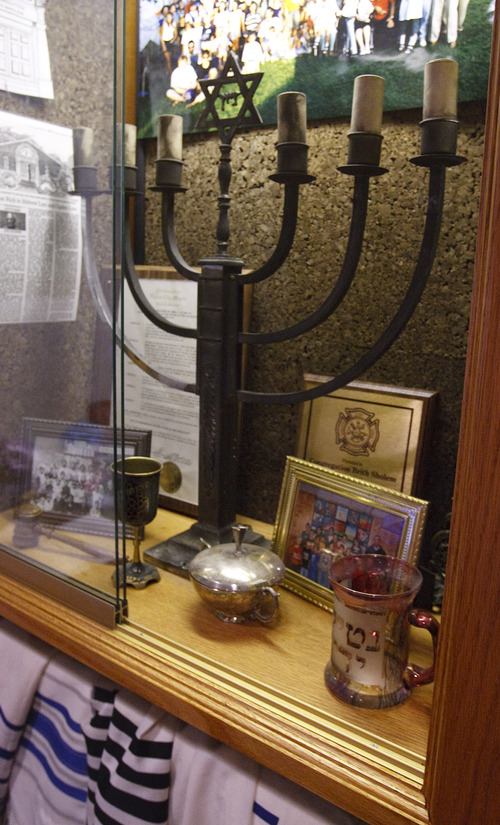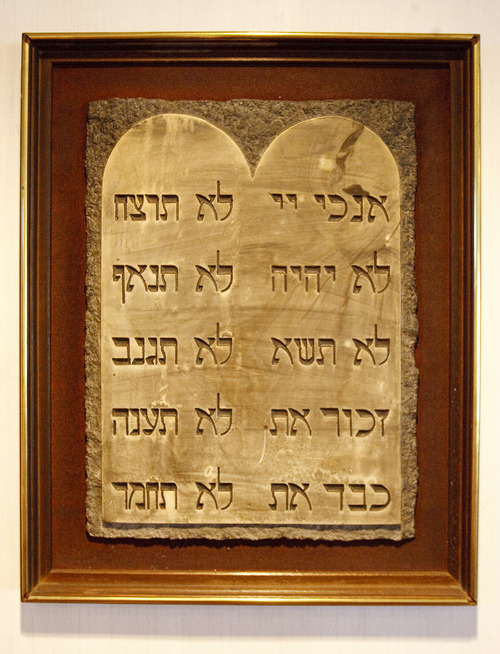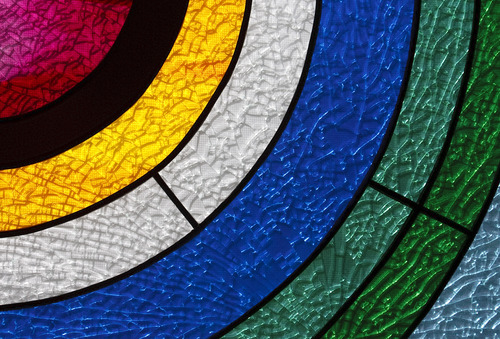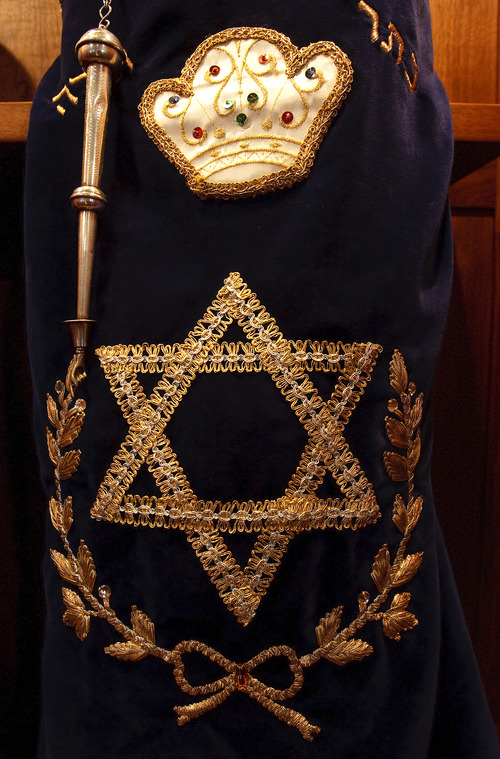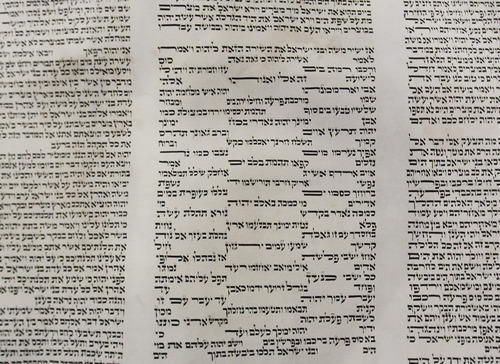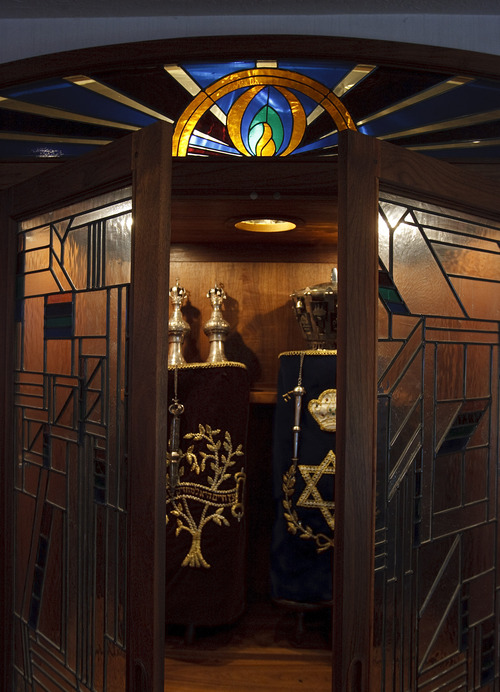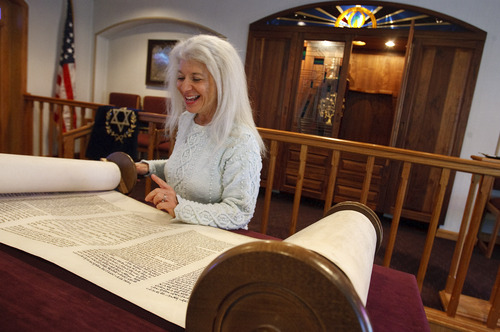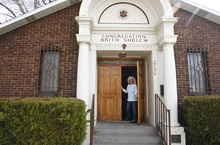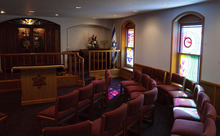This is an archived article that was published on sltrib.com in 2013, and information in the article may be outdated. It is provided only for personal research purposes and may not be reprinted.
Ogden • Shocked members of Ogden's small Jewish community awakened one morning to find their synagogue smoldering.
The interior of the building, which had stood on Ogden's Grant Avenue since 1921, was blackened — the result of a fire set by vandals the previous night in December 1989.
"There was talk at that time of moving somewhere else," recalled Pam Schneider, a longtime member of Congregation Brith Sholem, "but we decided to stay … having been there for so long already."
Instead of relocating, they rebuilt from the ashes. They accepted donations from Jews and non-Jews alike, made design decisions as a community and allowed congregants to contribute their talents.
Now, more than 23 years later, the result is a temple that looks, from the outside, nearly identical to the original, founded 92 years ago. It closely resembles the small houses that surround it — a red brick building covered with a white triangular roof. Two white columns frame the wooden double doors, above which is inscribed, "May the doors of this synagogue be wide enough for all to enter."
Inside, the sanctuary looks like those of its many modern counterparts, perhaps more minuscule to accommodate the congregation of about 45 families. Chairs fill the room, facing an ark holding two large Torah scrolls, believed to date back to 19th-century Europe. Somehow, the scrolls survived the flames.
Five colorful, stained-glass-like windows, designed by congregant Linda Zeveloff after the fire, adorn the walls. One represents the Torah, or Hebrew Bible, and the other four signify the seasons. The winter window, for example, features icy blues and red-orange squares scattered like stars through the sky and meant to represent candles lit during Hanukkah.
"It has this modern look on the inside," said temple president Judi Amsel, "but it's still the same footprint."
The congregation's founders from nearly a century ago would likely still recognize their spiritual home, at least from the outside, if not from the inside.
Jews, mostly of German heritage, began arriving in Ogden long before the northern Utah city had a synagogue, according to a video produced by the congregation in 1997. They likely left Salt Lake City for the once-lively Gentile town of Corinne, about 27 miles north of Ogden, in the latter half of the 1800s amid the coming of the railroad and a downturn for non-Mormon businesses as a result of the Zion's Cooperative Mercantile Institution movement, according to a National Register of Historic Places plaque marking the synagogue's exterior. Ogden's Jewish community likely sprouted from that history.
Eventually, a small group of Jews began meeting for services in Benjamin Oppman's clothing store on 25th Street in Ogden. In the years to come, most of the city's Jews would live on 25th Street, earning the area the nickname "Little Jerusalem."
They began meeting under the name Congregation Ohab Sholem in 1890 and followed Orthodox tradition.
In 1916, the group adopted the name Brith Sholem, meaning "Covenant of Peace." In 1921, about 1,000 people turned out to celebrate the temple's dedication.
At the time, the congregation was still Orthodox. Amsel said the group even dreamed of adding a second story to the sanctuary for women, who are separated from men during Orthodox services.
Through the years, the congregation changed as the community — and the world — shifted around it.
The congregation now practices Reform Judaism, and about half its families are interfaith, Amsel said.
Because the congregation is relatively small, it doesn't have a full-time rabbi, instead relying on Los Angeles rabbinical students, whom the synagogue flies in about once a month. That often means a heightened sense of responsibility among members, who must fill in when no rabbi is present.
Amsel said congregants take seriously their duty to show up for weekend services, knowing that without 10 adults — known as a minyan — they can't read from the Torah, per Jewish law. Also, members of the congregation often lead services.
"I love doing it," Amsel said. "It's one of my favorite things to do because then I get the service I like."
That includes teenagers who have recently had their bar or bat mitzvahs. In Judaism, a bar mitzvah (for a boy) and a bat mitzvah (for a girl) signify entry into Jewish adulthood.
"Here they really mean it," Amsel said, "because here they're going to be back up leading services the next month."
So far, two of Jenny Sheets' children have had bat mitzvahs at Brith Sholem, and her son is slated to have his in October. She said her children have grown up understanding that once they became Jewish adults, they'd take leadership roles within the synagogue.
"I don't know that they really know any different," Sheets said. "It's expected of them, and it's a way to give back because the community has given them so much."
Amsel, who is originally from New York, said the congregants are, in many ways, family to one another. Many members, like her, hail from out of state.
"The synagogue has to become the extended family and, to me, that's the metaphor for what we are here," she said, "because so many of us are isolated from our biological families."
Through the years, the larger non-Jewish community has embraced Brith Sholem as well.
In the congregation's 1997 video, the late Terri Kaufman, a past president, recalled that when she once approached Zions Bank looking to sell raffle tickets to raise money for a new synagogue roof, an executive there instead found a donor — later identified as the owner of a Layton lumber company — to build the roof for free.
And when vandals set fire to the shul in 1989, Amsel said, area Mormons stepped up, donating tens of thousands of dollars to help their Jewish neighbors rebuild.
She said it's still unknown who set the blaze and whether it was done out of hate, but members don't focus on that. The fire may have charred much of the Brith Sholem building, but it didn't destroy the congregation's history or spirit.
"The holiness is found in its people," Sheets said of Brith Sholem. "Our windows are beautiful, and it's small, but I think everything we feel really comes from each other."
Twitter: @lschencker —
About Congregation Brith Sholem
Location • 2750 Grant Ave., Ogden
Built • 1921
Interior Rebuilt • 1990
Features • Stained-glass-like windows, designed by a congregant, symbolize the four seasons and the Torah. At the front of the small sanctuary, an ark holds two large Torah scrolls, believed to date back to 19th-century Europe. —
'Where We Worship' series
Once a month throughout 2013, The Salt Lake Tribune is featuring Utah's sacred spaces — whether mighty cathedrals or modest meetinghouses. To read previous stories in the series, go to http://www.sltrib.com
Today • Ogden's Congregation Brith Sholem synagogue


